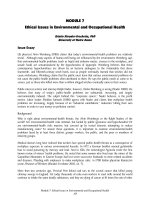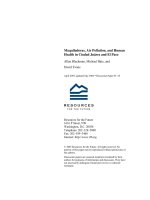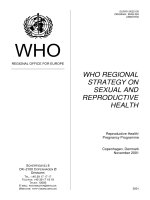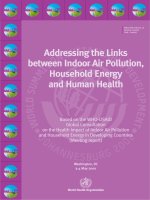Epigenetics and Human Health pptx
Bạn đang xem bản rút gọn của tài liệu. Xem và tải ngay bản đầy đủ của tài liệu tại đây (2.28 MB, 322 trang )
Epigenetics and Human Health
Edited by
Alexander G. Haslberger
Co-edited by
Sabine Gressler
Knasmüller, S., DeMarini, D. M.,
Johnson, I., Gerhäuser, C. (Eds.)
Chemoprevention of Cancer
and DNA Damage by Dietary
Factors
2009
ISBN: 978-3-527-32058-5
Allgayer, H., Rehder, H., Fulda, S. (Eds.)
Hereditary Tumors
From Genes to Clinical Consequences
2009
ISBN: 978-3-527-32028-8
Kahl, G.
The Dictionary of Genomics,
Transcriptomics and
Proteomics
2009
ISBN: 978-3-527-32073-8
Ziegler, A., Koenig, I. R.
A Statistical Approach
to Genetic Epidemiology
Concepts and Applications
Second Edition
2010
ISBN: 978-3-527-32389-0
Janitz, M. (Ed.)
Next Generation Genome
Sequencing
Towards Personalized Medicine
2008
ISBN: 978-3-527-32090-5
Kaput, J., Rodriguez, R. L. (Eds.)
Nutritional Genomics
Discovering the Path to Personalized
Nutrition
2005
ISBN: 978-0-471-68319-3
Related Titles
Epigenetics and Human Health
Linking Hereditary, Environmental and
Nutritional Aspects
Edited by
Alexander G. Haslberger
Co-edited by
Sabine Gressler
The Editor
Dr. Alexander G. Haslberger
University of Vienna
Department of Nutritional Sciences
Althanstrasse 14
1090 Vienna
Austria
The Co-editor
Mag. Sabine Gressler
Barichgasse 30/4/54
1030 Vienna
Austria
All books published by Wiley-VCH are carefully
produced. Nevertheless, authors, editors, and
publisher do not warrant the information
contained in these books, including this book, to
be free of errors. Readers are advised to keep in
mind that statements, data, illustrations,
procedural details or other items may
inadvertently be inaccurate.
Library of Congress Card No.: applied for
British Library Cataloguing-in-Publication Data
A catalogue record for this book is available from
the British Library.
Bibliographic information published by the
Deutsche Nationalbibliothek
The Deutsche Nationalbibliothek lists this
publication in the Deutsche Nationalbibliografi e;
detailed bibliographic data are available on the
Internet at <>.
© 2010 WILEY-VCH Verlag GmbH & Co.
KGaA, Weinheim
All rights reserved (including those of translation
into other languages). No part of this book may
be reproduced in any form – by photoprinting,
microfi lm, or any other means – nor transmitted
or translated into a machine language without
written permission from the publishers.
Registered names, trademarks, etc. used in this
book, even when not specifi cally marked as such,
are not to be considered unprotected by law.
Cover Design: Formgeber, Eppelheim
Composition SNP Best-set Typesetters Ltd.,
Hong Kong
Printing betz-druck GmbH, Darmstadt
Bookbinding Litges & Dopf GmbH,
Heppenheim
Printed in the Federal Republic of Germany
Printed on acid-free paper
ISBN: 978-3-527-32427-9
For Conny
VII
Epigenetics and Human Health
Edited by Alexander G. Haslberger, Co-edited by Sabine Gressler
Copyright © 2010 WILEY-VCH Verlag GmbH & Co. KGaA, Weinheim
ISBN: 978-3-527-32427-9
Contents
Preface XV
List of Contributors XVII
Part I General Introduction
1 The Research Program in Epigenetics: The Birth of a New Paradigm 3
Paolo Vineis
References 5
2 Interactions Between Nutrition and Health 7
Ibrahim Elmadfa
2.1 Introduction 7
2.2 Epigenetic Effects of the Diet 8
2.3 Current Nutrition Related Health Problems 8
References 9
3 Epigenetics: Comments from an Ecologist 11
Fritz Schiemer
References 12
4 Interaction of Hereditary and Epigenetic Mechanisms in
the Regulation of Gene Expression 13
Thaler Roman, Eva Aumüller, Carolin Berner, and Alexander G. Haslberger
4.1 Hereditary Dispositions 13
4.2 The Epigenome 14
4.3 Epigenetic Mechanisms 15
4.3.1 Methylation 15
4.3.2 Histone Modifi cations 18
4.3.3 Micro RNAs 20
4.4 Environmental Infl uences 20
4.4.1 Nutritional and Environmental Effects in Early Life Conditions 20
4.4.2 Environmental Pollution and Toxins 22
4.5 Dietary Effects 22
VIII Contents
4.5.1 Nutrition and the Immune System 26
4.5.2 Nutrition and Aging 26
4.6 Inheritance and Evolutionary Aspects 28
4.7 Conclusion 29
References 30
Part II Hereditary Aspects
5 Methylenetetrahydrofolate Reductase C677T and A1298C Polymorphisms
and Cancer Risk: A Review of the Published Meta-Analyses 37
Stefania Boccia
5.1 Key Concepts of Population-Based Genetic Association Studies 37
5.1.1 Defi nition and Goals of Genetic Epidemiology 37
5.1.2 Study Designs in Genetic Epidemiology 38
5.1.3 The Human Genome 38
5.1.4 Meta-Analysis in Genetic Epidemiology 39
5.1.5 Human Genome Epidemiology Network 40
5.1.6 “Mendelian Randomization” 41
5.2 Methylenetetrahydrofolate Reductase Gene Polymorphisms
(C677T and A1298C) and Its Association with Cancer Risk 41
5.2.1 Gene and Function 41
5.2.2 C677T and A1298C Gene Variants 43
5.2.3 Gene–Environment Interaction 43
5.3 Meta-Analyses of Methylenetetrahydrofolate Reductase C677T and
A1298C Polymorphisms and Cancer 44
References 47
6 The Role of Biobanks for the Understanding of Gene–Environment
Interactions 51
Christian Viertler, Michaela Mayrhofer, and Kurt Zatloukal
6.1 Background 51
6.1.1 What Purpose Do Different Biobank Formats Serve? 52
6.1.2 Why Do We Need Networks of Biobanks? 53
6.2 The Investigation of Gene–Environment Interactions as a Challenge
for Biobanks 55
6.2.1 How to Evaluate Risk Factors for Metabolic Syndrome and
Steatohepatitis? 58
6.2.2 Why Are Biobanks Needed in This Context and What Challenges Do
They Have to Face? 58
References 60
7 Case Studies on Epigenetic Inheritance 63
Gunnar Kaati
7.1 Introduction 64
7.2 Methodology 65
Contents IX
7.2.1 On the Study of Epigenetic Inheritance 65
7.2.2 The Ideal Study Design 66
7.2.3 The Överkalix Cohorts of 1890, 1905 and 1920 67
7.2.4 The ALSPAC Data Set 68
7.2.5 The Proband’s Childhood 68
7.2.6 Food Availability 69
7.2.7 Ancestors’ Experience of Crises 69
7.2.8 Growth Velocity 69
7.3 Patterns of Transgenerational Responses 70
7.3.1 The Social Context 70
7.3.2 The Ancestors’ Nutrition 71
7.3.3 Longevity and Paternal Ancestors’ Nutrition 71
7.3.4 The Infl uence of Nutrition During the Slow Growth Period on
Cardiovascular and Diabetes Mortality 72
7.3.5 Is Human Epigenetic Inheritance Mediated by the Sex
Chromosomes? 73
7.3.5.1 Paternal Initiation of Smoking and Pregnancy Outcome 75
7.3.6 Epigenetic Inheritance, Early Life Circumstances and Longevity 75
7.3.7 How to Explain the Effects of Food Availability During SGP on
Human Health? 76
7.3.7.1 Genetic Selection Through Differential Survival or Fertility? 76
7.3.7.2 Chromosomal Transmission of Nutritionally Induced Epigenetic
Modifi cations 76
7.4 Epigenetic Inheritance 77
7.4.1 Fetal Programming and Epigenetic Inheritance 78
7.5 Future Directions 80
7.6 Conclusions 81
References 83
Part III Environmental and Toxicological Aspects
8 Genotoxic, Non-Genotoxic and Epigenetic Mechanisms in Chemical
Hepatocarcinogenesis: Implications for Safety Evaluation 89
Wilfried Bursch
8.1 Introduction 90
8.2 Genotoxic and Non-Genotoxic Chemicals in Relation to the Multistage
Model of Cancer Development 91
8.2.1 Tumor Initiation 91
8.2.2 Tumor Promotion 92
8.2.3 Tumor Progression 93
8.2.4 Cellular and Molecular Mechanisms of Tumor Initiation and
Promotion 93
8.2.5 Epigenetic Effects of Genotoxic and Non-Genotoxic
Hepatocarcinogens 96
X Contents
8.2.6 How Carcinogens Alter the Microenvironment – Crucial Roles
of Infl ammation 97
8.3 Concluding Remarks 97
References 99
9 Carcinogens in Foods: Occurrence, Modes of Action and Modulation
of Human Risks by Genetic Factors and Dietary Constituents 105
M. Mišík, A. Nersesyan, W. Parzefall, and S. Knasmüller
9.1 Introduction 105
9.2 Genotoxic Carcinogens in Human Foods 106
9.2.1 Polycyclic Aromatic Hydrocarbons 107
9.2.2 Nitrosamines 107
9.2.3 Heterocyclic Aromatic Amines (HAAs) and Other Thermal
Degradation Products 108
9.2.4 Mycotoxins 109
9.2.5 Food Additives and Carcinogens in Plant-Derived Foods 109
9.2.6 Alcohol 111
9.3 Contribution of Genotoxic Dietary Carcinogens to Human Cancer
Risks 111
9.4 Protective Effects of Dietary Components Towards DNA-Reactive
Carcinogens 112
9.5 Gene Polymorphisms Affecting the Metabolism of Genotoxic
Carcinogens 114
9.6 Concluding Remarks, Epigenetics and Outlook 118
References 118
Part IV Nutritional Aspects
10 From Molecular Nutrition to Nutritional Systems Biology 127
Guy Vergères
10.1 Impact of Life Sciences on Molecular Nutrition Research 127
10.2 Nutrigenomics 129
10.2.1 Genomics and Nutrition Research 129
10.2.2 Transcriptomics and Nutrition Research 130
10.2.3 Proteomics and Nutrition Research 131
10.2.4 Metabolomics and Nutrition Research 132
10.3 Nutrigenetics 133
10.4 Nutri-Epigenetics 135
10.5 Nutritional Systems Biology 137
10.6 Ethics and Socio-Economics of Modern Nutrition Research 137
References 139
Contents XI
11 Effects of Dietary Natural Compounds on DNA Methylation Related to
Cancer Chemoprevention and Anticancer Epigenetic Therapy 141
Barbara Maria Stefanska and Krystyna Fabianowska-Majewska
11.1 Introduction 141
11.2 DNA Methylation Reaction 142
11.3 Implication of the Selected Natural Compounds in DNA Methylation
Regulation 144
11.3.1 ATRA, Vitamin D
3
, Resveratrol, and Genistein 144
11.3.1.1 Involvement of p21
WAF1/CIP1
and Rb/E2F Pathway in Regulation
of DNMT1 147
11.3.1.2 Involvement of the AP-1 Transcriptional Complex in Regulation
of DNMT1 148
11.3.2 Polyphenols with a Catechol Group 149
11.4 Conclusions and Future Perspectives 151
References 152
12 Health Determinants Throughout the Life Cycle 157
Petra Rust
12.1 Introduction 157
12.2 Pre- and Postnatal Determinants 159
12.3 Determinants During Infancy and Adulthood 160
12.4 Determinants in Adults and Older People 160
12.5 Interactions Throughout the Lifecycle 161
12.6 Intergenerational Effects 161
References 162
Part V Case Studies
13 Viral Infections and Epigenetic Control Mechanisms 167
Klaus R. Huber
13.1 The Evolutionary Need for Control Mechanisms 167
13.2 Control by RNA Silencing 168
13.3 Viral Infections and Epigenetic Control Mechanisms 169
13.3.1 RNA Silencing in Plants 169
13.3.2 RNA Silencing in Fungi 170
13.3.3 RNA Silencing in Mammals 170
13.4 Epigenetics and Adaptive Immune Responses 171
References 171
14 Epigenetics Aspects in Gyneacology and Reproductive Medicine 173
Alexander Just and Johannes Huber
References 178
XII Contents
15 Epigenetics and Tumorigenesis 179
Heidrun Karlic and Franz Varga
15.1 Introduction 179
15.2 Role of Metabolism Within the Epigenetic Network 181
15.3 Epigenetic Modifi cation by DNA Methylation During Lifetime 183
15.4 Interaction of Genetic and Epigenetic Mechanisms in Cancer 184
15.5 DNA Methylation in Normal and Cancer Cells 185
15.6 Promoter Hypermethylation in Hematopoietic Malignancies 186
15.7 Hypermethylated Gene Promoters in Solid Cancers 187
15.8 Interaction DNA Methylation and Chromatin 188
References 190
16 Epigenetic Approaches in Oncology 195
Sabine Zöchbauer-Müller and Robert M. Mader
16.1 Introduction 195
16.2 DNA Methylation, Chromatin and Transcription 196
16.3 Methods for Detecting Methylation 197
16.4 The Paradigm of Lung Cancer 198
16.4.1 Frequently Methylated Tumor Suppressor Genes and Other
Cancer-Related Genes in Lung Carcinomas 199
16.4.2 Monitoring of DNA Methylation in Blood Samples 200
16.5 Epigenetics and Therapy 200
16.6 Epigenetic Alterations Under Cytotoxic Stress 201
16.7 Therapeutic Applications of Inhibitors of DNA Methylation 202
16.8 How May Methylation Become Relevant to Clinical
Applications? 203
16.9 Conclusions 204
References 205
17 Epigenetic Dysregulation in Aging and Cancer 209
Despina Komninou and John P. Richie
17.1 Introduction 210
17.2 The Cancer-Prone Metabolic Phenotype of Aging 210
17.3 Age-Related Epigenetic Silencing Via DNA Methylation 212
17.4 Infl ammatory Control of Age-Related Epigenetic Regulators 214
17.5 Lessons from Anti-Aging Modalities 215
17.6 Conclusions 217
References 218
18 The Impact of Genetic and Environmental Factors in Neurodegeneration:
Emerging Role of Epigenetics 225
Lucia Migliore and Fabio Coppedè
18.1 Neurodegenerative Diseases 225
18.2 The Role of Causative and Susceptibility Genes in Neurodegenerative
Diseases 226
Contents XIII
18.3 The Contribution of Environmental Factors to Neurodegenerative
Diseases 231
18.4 Epigenetics, Environment and Susceptibility to Human Diseases 233
18.5 Epigenetics and Neurodegenerative Diseases 234
18.6 The Epigenetic Role of the Diet in Neurodegenerative Diseases 237
18.7 Concluding Remarks 238
References 239
19 Epigenetic Biomarkers in Neurodegenerative Disorders 245
Borut Peterlin
19.1 Introduction 245
19.2 Epigenetic Marks in Inherited Neurological and Neurodegenerative
Disorders 246
19.3 Epigenetic Dysregulation in Neurodegenerative Disorders 247
19.4 Gene Candidates for Epigenetic Biomarkers 248
19.5 Conclusions 249
References 250
20 Epigenetic Mechanisms in Asthma 253
Rachel L. Miller and Julie Herbstman
20.1 Introduction 253
20.2 Epigenetic Mechanisms 255
20.3 Fetal Basis of Adult Disease 255
20.4 Fetal Basis of Asthma 256
20.5 Experimental Evidence 257
20.6 Epigenetic Mechanisms in Asthma 257
20.7 Cell-Specifi c Responses 259
20.8 Conclusion 259
References 260
Part VI Ways to Translate the Concept
21 Public Health Genomics – Integrating Genomics and Epigenetics into
National and European Health Strategies and Policies 267
Tobias Schulte in den Bäumen and Angela Brand
21.1 Public Health and Genomics 267
21.2 The Bellagio Model of Public Health Genomics 268
21.3 The Public Health Genomics European Network 271
21.4 From Public Health Genomics to Public Health and Epigenetics/
Epigenomics 272
21.5 Health in All Policies – Translating Epigenetics/Epigenomics into
Policies and Practice 272
21.6 Health in All Policies as a Guiding Concept for European
Policies 273
21.7 Relative Risk and Risk Regulation – A Model for the Regulation
of Epigenetic Risks? 274
XIV Contents
21.8 Attributable Risks and Risk Regulation 275
21.9 Translating Attributable Risks into Policies 275
21.10 Limits to the Concept of Health in All Policies in Genomics and
Epigenetics 277
21.11 Conclusion 278
References 278
22 Taking a First Step: Epigenetic Health and Responsibility 281
Astrid H. Gesche
22.1 Introduction 281
22.2 Responding to Epigenetic Challenges 282
22.3 Responsibility and Public Health Care Policy 283
22.4 Conclusion 284
References 285
Index 287
Preface
XV
We all know only too well that our way of life, the food we eat, smoking, stress or
environmental toxins infl uence our health. But we have just started to learn how
these environmental factors cooperate with our hereditary genetic dispositions to
determine health or the development of diseases.
Moreover, we did not know until recently that all these factors may also infl u-
ence the health of our children and grandchildren to whom we may transmit
functional changes of our genes. Are we really responsible for the well - being of
our unborn descendants?
Does nutrition or stress in our early childhood and in our daily life determine
functions of genes and tissues by epigenetic mechanisms? And how does this
infl uence change during life affecting ageing and longevity? To what extent is
there an inheritance of environmentally acquired characteristics? These are
main questions in epigenetics, a new and exciting hot topic in natural sciences
linking multiple hereditary and environmental impacts on our health ( http://www.
integratedhealthcare.eu ).
It has been noted in an article “ Epigenetics: The Science of Change ” of the
Environmental Health Perspectives , that interest in epigenetics is increasing “ as it
has become clear that understanding epigenetics and epigenomics – the genome-
wide distribution of epigenetic changes – will be essential in work related to
many other topics requiring a thorough understanding of all aspects of genetics,
such as stem cells, cloning, aging, synthetic biology, species conservation, evolu-
tion, and agri culture ” ( />html ). Because of this interaction of epigenetics with so many scientifi c and
technological fi elds, epigenetics will be at the center of public, governmental and
scientifi c interest.
There are now great books available which thoroughly describe mechanisms of
epigenetics. The idea for this book was born at a meeting at the University of
Vienna where participants from different areas of nutrition, environmental and
molecular biology stressed the need of more discussion on concepts towards
environmental health interactions between scientists of these disciplines.
Clearly the more optimistic aspect of the possibility to prevent, interfere or even
correct epigenetic marks which could result in hazards for diseases, e.g. by dietary
concepts or changes of our personal environment and lifestyle, encourages the
Epigenetics and Human Health
Edited by Alexander G. Haslberger, Co-edited by Sabine Gressler
Copyright © 2010 WILEY-VCH Verlag GmbH & Co. KGaA, Weinheim
ISBN: 978-3-527-32427-9
XVI Preface
work in epigenetics. In contrast many results from the analysis of hereditary
genetic dispositions can only be respected.
This book picks a transdisciplinary approach focusing on the new understand-
ing of epigenetic and gene - environment interactions for scientifi c, biomedical,
toxicological, environmental, nutritional, evolutionary and regulatory aspects. It
focuses on the views of the many exceptional scientists working in these different
areas towards epigenetics and health environmental interactions.
The articles in Part I of the book emphasize the interactions between concepts
of genetic diversity, epigenetics, environmental health, molecular epidemiology,
nutrition and evolution theory. Part II focuses on hereditary aspects, Part III on
environmental and toxicological aspects. Part IV extends on nutritional aspects.
In Part V the new understanding of epigenetics and environmental health inter-
actions is detailed in case studies of fi elds such as gynecology, oncology, infectious
diseases, asthma, or neurodegenerative diseases. The last Part VI explores con-
cepts to translate the new understanding into public health policies and strategies
including principal ethical aspects.
The book is targeted at scientists, environmental, nutritional and health experts,
geneticists, experts in science communication, policy makers, experts from stan-
dard setting authorities, teachers as well as scientifi cally experienced consumers
interested in interdisciplinary aspects in this area.
The major objective of the book is to strengthen the understanding of interac-
tions between hereditary, genetic and environmental interactions and to bridge
gaps which often have evolved between scientifi c disciplines of molecular, genetic
and biotechnological areas on one side and environmental oriented sciences,
conservation biology and environmental health on the other.
We thank all the brilliant authors who have contributed, as the summary of their
distinguished views on this complex area is the essence of this book.
We do hope that you all enjoy the rather rough ride through the newly emerging
and exciting fi elds of epigenetics!
Vienna, September 2009 Alexander G. Haslberger
Acknowledgment
We thank the Austrian Federal Ministry of Science and Research and the Forum
of Austrian Scientists for Environmental Protection ( />htm ) for support and many dedicated scientists and colleagues, especially MR Dr.
Christian Smoliner for stimulating discussions.
List of Contributors
XVII
Epigenetics and Human Health
Edited by Alexander G. Haslberger, Co-edited by Sabine Gressler
Copyright © 2010 WILEY-VCH Verlag GmbH & Co. KGaA, Weinheim
ISBN: 978-3-527-32427-9
Eva Aum ü ller
University of Vienna
Department of Nutritional
Sciences
Althanstrasse 14
1090 Vienna
Austria
Tobias Schulte in den B ä umen
Maastricht University
European Centre for Public
Health Genomics
Faculty of Health
Medicine and Life Sciences
Universiteitssingel 40 West
6229 ER Maastricht - Randwijck
The Netherlands
Carolin Berner
University of Vienna
Department of Nutritional
Sciences
Althanstrasse 14
1090 Vienna
Austria
Stefania Boccia
Universit à Cattolica del Sacro Cuore
Institute of Hygiene
Genetic Epidemiology and
Molecular Biology Unit
Largo Francesco Vito, 1
00168 Rome
Italy
Angela Brand
Maastricht University
European Centre for Public
Health Genomics
Faculty of Health
Medicine and Life Sciences
Universiteitssingel 40 West
6229 ER Maastricht - Randwijck
The Netherlands
Wilfried Bursch
Medical University of Vienna
Department of Medicine
Institute of Cancer Research
Chemical Safety and Cancer
Prevention
Borschkegasse 8a
1090 Vienna
Austria
XVIII List of Contributors
Fabio Copped è
University of Pisa
Department of Neuroscience
Via Roma 67
56126 Pisa
Italy
Ibrahim Elmadfa
University of Vienna
Department of Nutritional
Sciences
Althanstrasse 14
1090 Vienna
Austria
Krystyna Fabianowska - Majewska
Medical University of Lodz
Department of Biomedical
Chemistry
Lindleya 6
90–131 Lodz
Poland
Astrid H. Gesche
University of New England
Faculty of Arts and Sciences
Armidale, NSW 2351
Australia
Alexander G. Haslberger
University of Vienna
Department of Nutritional
Sciences
Althanstrasse 14
1090 Vienna
Austria
Julie Herbstman
Columbia University
Mailman School of Public Health
Department of Environmental
Health Sciences
100 Haven Ave #25F
New York, NY 10032
USA
Johannes Huber
University Hospital Vienna
Department of Gynecological
Endocrinology and Reproductive
Medicine
W ä hringer G ü rtel 18 – 20
1090 Vienna
Austria
Klaus R. Huber
Danube Hospital Vienna
Institute of Laboratory Medicine
Langobardenstrasse 122
1120 Vienna
Austria
Alexander Just
University Hospital Vienna
Department of Gynecological
Endocrinology and Reproductive
Medicine
W ä hringer G ü rtel 18 – 20
1090 Vienna
Austria
Gunnar Kaati
University of Ume å
Department of Public Health and
Clinical Medicine
Building 1A
90185 Umea
Sweden
Heidrun Karlic
Hanusch Hospital
Ludwig Boltzmann Institute
for Leukemia Research
Heinrich Collin Strasse 30
1140 Vienna
Austria
List of Contributors XIX
Rachel L. Miller
Columbia University
College of Physicians and Surgeons
Department of Medicine
Division of Pulmonary Allergy
and Critical Care Medicine
630 West 168th Street
New York, NY 10032
USA
Miroslav Mi š í k
Medical University of Vienna
Department of Medicine
Institute of Cancer Research
Chemical Safety and Cancer
Prevention
Borschkegasse 8A
1090 Vienna
Austria
Armen Nersesyan
Medical University of Vienna
Department of Medicine
Institute of Cancer Research
Chemical Safety and Cancer
Prevention
Borschkegasse 8A
1090 Vienna
Austria
Wolfram Parzefall
Medical University of Vienna
Department of Medicine
Institute of Cancer Research
Chemical Safety and Cancer Prevention
Borschkegasse 8A
1090 Vienna
Austria
Siegfried Knasm ü ller
Medical University of Vienna
Department of Medicine
Institute of Cancer Research
Chemical Safety and Cancer
Prevention
Borschkegasse 8A
1090 Vienna
Austria
Despina Komninou
Nutrition and Disease
Prevention Center
31 - 11, 31st Avenue
Long Island City, NY 11106
USA
Robert M. Mader
Medical University of Vienna
Department of Medicine
Division of Oncology
W ä hringer G ü rtel 18 – 20
1090 Vienna
Austria
Michaela Theresia Mayrhofer
Medical University of Graz
Institute of Pathology
Auenbrugger Platz 25
8036 Graz
Austria
Lucia Migliore
University of Pisa
Department of Human and
Environmental Science
Via San Giuseppe 22
56126 Pisa
Italy
XX List of Contributors
Borut Peterlin
University Medical Center
Ljubljana
Institute of Medical Genetics
Department of Obstetrics and
Gynecology
Slajmerjeva 3
1000 Ljubljana
Slovenia
John P. Richie
Pennsylvauia State University
College of Medicine
Department of Public Health
Sciences
500 University Drive
Hershey, PA 17033
USA
Thaler Roman
University of Vienna
Department of Nutritional
Sciences
Althanstrasse 14
1090 Vienna
Austria
Petra Rust
University of Vienna
Department of Nutritional
Sciences
Althanstrasse 14
1090 Vienna
Austria
Fritz Schiemer
University of Vienna
Center for Ecology
Althanstrasse 14
1090 Vienna
Austria
Barbara Maria Stefanska
Medical University of Lodz
Department of Biomedical Chemistry
Lindleya 6
90–131 Lodz
Poland
Franz Varga
Hanusch Hospital
Ludwig Boltzmann Institute of
Osteology
Heinrich Collin Strasse 30
1140 Vienna
Austria
Guy Verg è res
Federal Department of Economics
Affairs
Agroscope Liebefeld - Posieux
Research Station
Schwarzenburgstrasse 161
3003 Berne
Switzerland
Christian Viertler
Medical University of Graz
Institute of Pathology
Auenbrugger Platz 25
8036 Graz
Austria
Paolo Vineis
Imperial College London
MRC Centre for Environment
and Health
St Mary ’ s Campus
Norfolk Place
London W2 1PG
UK
List of Contributors XXI
Kurt Zatloukal
Medical University of Graz
Institute of Pathology
Auenbrugger Platz 25
8036 Graz
Austria
Sabine Z ö chbauer - M ü ller
Medical University of Vienna
Department of Medicine
Division of Oncology
W ä hringer G ü rtel 18 – 20
1090 Vienna
Austria
General Introduction
Part I
Epigenetics and Human Health
Edited by Alexander G. Haslberger, Co-edited by Sabine Gressler
Copyright © 2010 WILEY-VCH Verlag GmbH & Co. KGaA, Weinheim
ISBN: 978-3-527-32427-9









